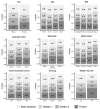Dietary Patterns and Their Sociodemographic and Lifestyle Determinants in Switzerland: Results from the National Nutrition Survey menuCH
- PMID: 30597962
- PMCID: PMC6356790
- DOI: 10.3390/nu11010062
Dietary Patterns and Their Sociodemographic and Lifestyle Determinants in Switzerland: Results from the National Nutrition Survey menuCH
Abstract
From a public health perspective, determinants of diets are crucial to identify, but they remain unclear in Switzerland. Hence, we sought to define current dietary patterns and their sociodemographic and lifestyle determinants using the national nutrition survey menuCH (2014⁻2015, n = 2057). First, we applied multiple factorial analysis and hierarchical clustering on the energy-standardised daily consumption of 17 food categories. Four dietary patterns were identified ("Swiss traditional": high intakes of dairy products and chocolate, n = 744; "Western 1": soft drinks and meat, n = 383; "Western 2": alcohol, meat and starchy, n = 444; and "Prudent": n = 486). Second, we used multinomial logistic regression to examine the determinants of the four dietary patterns: ten sociodemographic or lifestyle factors (sex, age, body mass index, language region, nationality, marital status, income, physical activity, smoking status, and being on a weight-loss diet) were significantly associated with the dietary patterns. Notably, belonging to the French- and Italian-speaking regions of Switzerland increased the odds of following a "Prudent" diet (Odds ratio [95% confidence interval]: 1.92 [1.45⁻2.53] and 1.68 [0.98⁻2.90], respectively) compared to the German-speaking regions. Our findings highlight the influence of sociodemographic and lifestyle parameters on diet and the particularities of the language regions of Switzerland. These results provide the basis for public health interventions targeted for population subgroups.
Keywords: 24-h recall; clustering; dietary survey; language region; multinomial logistic regression.
Conflict of interest statement
The authors declare no conflicts of interest. The funders had no role in the design of the study; in the collection, analyses, or interpretation of data; in the writing of the manuscript, or in the decision to publish the results.
Figures




Similar articles
-
Cultural Differences in Diet and Determinants of Diet Quality in Switzerland: Results from the National Nutrition Survey menuCH.Nutrients. 2019 Jan 9;11(1):126. doi: 10.3390/nu11010126. Nutrients. 2019. PMID: 30634520 Free PMC article.
-
Major Differences in Diet across Three Linguistic Regions of Switzerland: Results from the First National Nutrition Survey menuCH.Nutrients. 2017 Oct 25;9(11):1163. doi: 10.3390/nu9111163. Nutrients. 2017. PMID: 29068399 Free PMC article.
-
Characterisation of meat consumption across socio-demographic, lifestyle and anthropometric groups in Switzerland: results from the National Nutrition Survey menuCH.Public Health Nutr. 2022 Nov;25(11):3096-3106. doi: 10.1017/S136898002200101X. Epub 2022 Apr 25. Public Health Nutr. 2022. PMID: 35466905 Free PMC article.
-
Clustering of sociodemographic and lifestyle factors among adults with excess weight in a multilingual country.Nutrition. 2019 Jun;62:177-185. doi: 10.1016/j.nut.2019.01.001. Epub 2019 Jan 12. Nutrition. 2019. PMID: 30921554
-
[Simple obesity in children. A study on the role of nutritional factors].Med Wieku Rozwoj. 2006 Jan-Mar;10(1):3-191. Med Wieku Rozwoj. 2006. PMID: 16733288 Review. Polish.
Cited by
-
Development of a Multilingual Web-Based Food Frequency Questionnaire for Adults in Switzerland.Nutrients. 2023 Oct 13;15(20):4359. doi: 10.3390/nu15204359. Nutrients. 2023. PMID: 37892434 Free PMC article.
-
The relationship between lifestyle components and dietary patterns.Proc Nutr Soc. 2020 Aug;79(3):311-323. doi: 10.1017/S0029665120006898. Epub 2020 Apr 1. Proc Nutr Soc. 2020. PMID: 32234085 Free PMC article.
-
Is There a Potential Market for A2 Milk? Consumer Perception of Dairy Production and Consumption.Foods. 2025 Jul 22;14(15):2567. doi: 10.3390/foods14152567. Foods. 2025. PMID: 40807504 Free PMC article.
-
The Importance of Sweet Beverage Definitions When Targeting Health Policies-The Case of Switzerland.Nutrients. 2020 Jul 3;12(7):1976. doi: 10.3390/nu12071976. Nutrients. 2020. PMID: 32635195 Free PMC article.
-
Alcohol consumption: context and association with mortality in Switzerland.Eur J Nutr. 2023 Apr;62(3):1331-1344. doi: 10.1007/s00394-022-03073-w. Epub 2022 Dec 24. Eur J Nutr. 2023. PMID: 36564527 Free PMC article.
References
-
- World Health Organization . World Health Statistics 2016: Monitoring Health for the SDGs. WHO Press; Geneva, Switzerland: 2016. Annex B: Tables of Health Statistics by Country, WHO Region and Globally.
-
- Organisation for Economic Co-Operation and Development . Obesity and the Economics of Prevention: Fit Not Fat Key Facts—Switzerland, Update 2014. OECD Publishing; Paris, France: 2014.
-
- Swiss Health Observatory Indicators. [(accessed on 12 February 2018)];2018 Available online: https://www.obsan.admin.ch/de/indikatoren.
MeSH terms
Grants and funding
LinkOut - more resources
Full Text Sources

